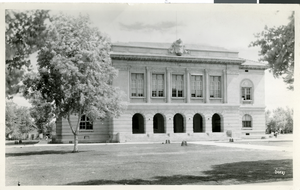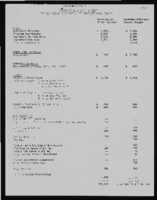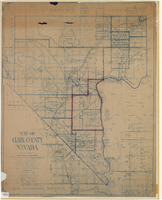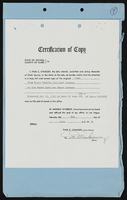Search the Special Collections and Archives Portal
Search Results

Photograph of Clark County Courthouse
Date
Archival Collection
Description
Image
Las Vegas-Clark County Consolidation Records
Identifier
Abstract
The Las Vegas-Clark County Consolidation Records (1976-1989) consist of newspaper articles, interviews, and legislative records. Material was donated by Jim Azar from his research for a professional paper in Public Administration, at the University of Nevada, Las Vegas, "Blurred Boundaries and Business Licensing," which he completed in 1993.
Archival Collection
Clark County Planning Commission Research Library Collection
Identifier
Abstract
The Clark County Planning Commission Research Library Collection (1911-2004) consists of reports, publications, and proposals gathered by the Clark County Planning Commission that focus on the environmental impact of proposed developments, construction, or infrastructure improvements around the county. The collection contains materials related to various local, state, federal, and inter-agency workshops, committees, and agencies. Documents include activity reports, impact statements, annual budgets and reports, and detailed studies. The majority of the collection dates from 1970 to 1999.
Archival Collection

Economic Opportunity Board of Clark County (Nev.) financial and budget reports
Date
Archival Collection
Description
From the Clark County Economic Opportunity Board Records -- Series I. Administrative. This folder contains financial memos and reports of the Clark County Economic Opportunity Board from 1964 through 1965.
Text
Clark County 208 Water Quality Management Plan Records
Identifier
Abstract
The Clark County 208 Water Quality Management Plan Records contain reports produced by consultants and agencies for the Clark County Board of County Commissioners to create the Clark County, Nevada 208 Water Quality Management Plan (1960-1990). The collection also includes amendments and studies about the implementation of the plan.
Archival Collection

State of Nevada, County of Clark
Date
Archival Collection
Description
Text

Map of Clark County, Nevada, 1927
Date
Description
Image

State of Nevada, County of Clark
Date
Archival Collection
Description
Text
Nye County, Nevada Photograph Collection
Identifier
Abstract
The Nye County, Nevada Photograph Collection contains photographs from Nye County, Nevada from 1880 to 1990. The collection includes a wide variety of photographs that document the activities, landmarks, geographical features, towns, ranches, and families of Nye County. The collection covers the areas of Amargosa Valley, Ash Meadows, Beatty, Duckwater, Gabbs, Goldfield, Kawich Mountains, Manhattan, Pahrump, Round Mountain, Rhyolite, Smoky Valley, Springdale, Tecopa, Tonopah, and Twin Springs. The activities documented include mining, prospecting, herding animals, schooling, ranching, building construction, railroad construction, and hunting and fishing.
Archival Collection

Postcard of the Clark County Courthouse
Date
Archival Collection
Description
Image
